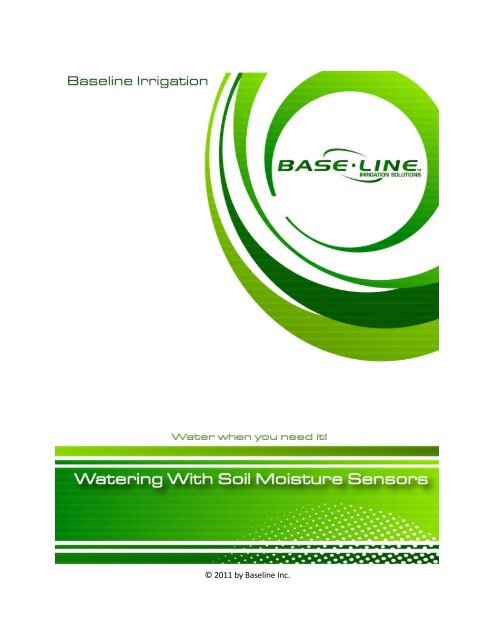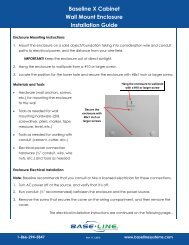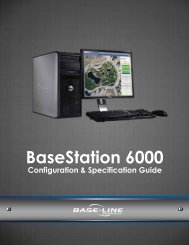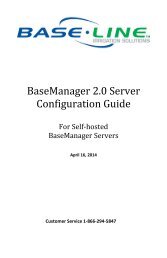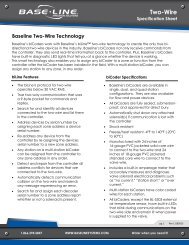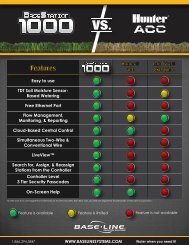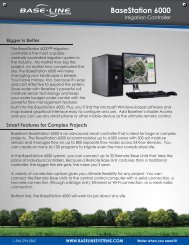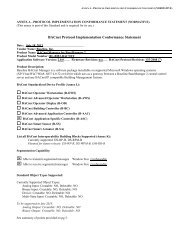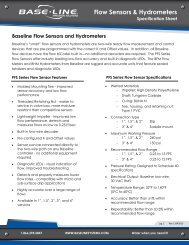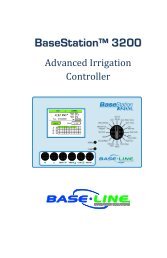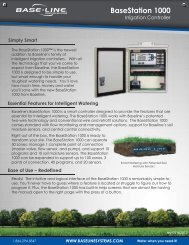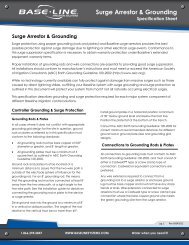Watering with Soil Moisture Sensors - Baseline Systems
Watering with Soil Moisture Sensors - Baseline Systems
Watering with Soil Moisture Sensors - Baseline Systems
Create successful ePaper yourself
Turn your PDF publications into a flip-book with our unique Google optimized e-Paper software.
© 2011 by <strong>Baseline</strong> Inc.
©2011, <strong>Baseline</strong> Irrigation SolutionsTable of ContentsCommon Myths............................................................................................................................................. 2<strong>Baseline</strong> <strong>Soil</strong> <strong>Moisture</strong> Sensor Technology ................................................................................................... 4What does it take to make a great soil moisture sensor? ........................................................................ 4How do soil moisture sensors work? ........................................................................................................ 4How can soil moisture sensor readings affect irrigation schedules? ........................................................ 4What is a good irrigator trying to accomplish? ............................................................................................. 5Why is it so challenging to water efficiently and effectively? .................................................................. 5How <strong>Baseline</strong>’s <strong>Soil</strong> <strong>Moisture</strong> <strong>Sensors</strong> Can Help You Meet Your Goals .................................................. 13Special <strong>Soil</strong> <strong>Moisture</strong> Sensor Applications .................................................................................................. 17Sports Fields and High Use Areas ............................................................................................................ 17Engineered Environments (Green Roofs, Green Walls, Interior Plantings) ............................................ 17Steep Slopes ............................................................................................................................................ 18Subsurface Drip Tubing Irrigation ........................................................................................................... 18Point Source Drip Irrigation .................................................................................................................... 19Water Feature/Cistern Keep Fill ............................................................................................................. 20Heavy Clay ............................................................................................................................................... 21Coarse Sand............................................................................................................................................. 21Frequently Asked Questions ....................................................................................................................... 23Glossary of Terms........................................................................................................................................ 26<strong>Watering</strong> <strong>with</strong> <strong>Soil</strong> <strong>Moisture</strong> <strong>Sensors</strong>1 | P age
©2011, <strong>Baseline</strong> Irrigation Solutions<strong>Watering</strong> <strong>with</strong> <strong>Soil</strong> <strong>Moisture</strong> <strong>Sensors</strong>Studies have shown that a properly configured soil moisture sensor can reduce outdoor water use by upto 62 percent or more over traditional irrigation methods. By watering your plants when needed, youcan increase landscape health, promote deeper root growth, and make your plants more diseaseresistant.If something as simple as a soil moisture sensor delivers all these benefits, then why isn’t this valuabletool used on every irrigation system? Unfortunately, professional irrigators are often familiar <strong>with</strong>inferior soil moisture sensors that do not deliver expected results, and this experience has discreditedthe value of all soil moisture sensors. Additionally, when deciding how to irrigate, people don’t alwaysconsider how water moves in soil, how the various types of soil retain moisture, and how plants’ needsdiffer.The purpose of this document is to establish the reputation of the <strong>Baseline</strong> soil moisture sensor as avaluable irrigation tool and to help professional irrigators meet their challenges by raising theirawareness of the issues related to effective watering.Common MythsBefore we start discussing the benefits of using soil moisture sensors and covering the details of thetechnology, we should attempt to dispel the common myths that always seem to surface whenever thistopic comes up. If you have doubts about the effectiveness of soil moisture sensors, we encourage youto review the following information.Myth #1 “I used a soil moisture sensor before and it did not work!”Several kinds of soil moisture sensors have been used for irrigation management and automation duringthe past 50 years, but not always successfully. Certainly some of the failures can be attributed toproduct issues, and some failures can be blamed on misuse or misunderstood soil conditions.Not all soil moisture sensors are created equal. The design and technology of <strong>Baseline</strong>’s soil moisturesensors make them the most advanced sensors in today’s market. <strong>Baseline</strong> sensors can reliably trackchanges in soil moisture content at less than 1/10 th of a percent, and the sensors are expected to last 25years in the soil regardless of climate. If you have had a negative experience <strong>with</strong> another type of soilmoisture sensor, you might want to reconsider <strong>Baseline</strong>’s version of this valuable irrigation managementtool.<strong>Watering</strong> <strong>with</strong> <strong>Soil</strong> <strong>Moisture</strong> <strong>Sensors</strong>2 | P age
©2011, <strong>Baseline</strong> Irrigation SolutionsMyth #2 “I have different soil types in my landscape, so a soil moisture sensor won’t work forme.”When we see a plant in the landscape that is doing poorly, we often assume that it’s not getting enoughwater, and if the poor-looking plant is located near other healthy plants, it’s typical to assume that thewater-holding issues are due to variations in soil type. In an effort to get extra water to the poor-lookingplant, we can easily end up overwatering the zone.While it’s true that variations in plant appearance are usually related to variations in soil type, theprimary factor is the nutrient-holding capacity of the soil, rather than the water-holding capacity. If youuse a soil moisture sensor to ensure that you are not under or over watering, you can isolate thenutrient-related issues and then treat them accordingly.Myth #3 “<strong>Soil</strong> moisture sensors probably work better in a high rainfall area, but I live in thedesert.”In a desert climate, the surface of the soil dries out quickly, but adequate moisture is often available inthe root zone of adapted plants. If you are serious about conserving water and maintaining healthyplants in a desert climate, a soil moisture sensor is a valuable tool.Without a soil moisture sensor, you have to continually monitor your plants for signs of stress and makeassumptions about the cause, and then base your remedies on those assumptions. The soil moisturesensor eliminates the need for constant monitoring and guesswork based on general observations.Myth #4 “<strong>Soil</strong> moisture sensors probably work well in the desert, but we get rain here.”Installing a soil moisture sensor in a wet climate allows you to conserve water by making better use ofeffective rainfall. The soil moisture sensor detects the rainfall that reaches the root zone (the “effective”rainfall), and adjusts the irrigation schedule accordingly. In a wet climate, a soil moisture sensor helpsprevent overwatering that often drowns plants especially while they are getting established in a newlandscape. If you are a contractor who is monitoring a new landscape, you’ll find that soil moisturesensors are a wise investment because they can prevent the costly and time-consuming efforts of havingto replace plant material that died due to improper watering.Myth #5 “<strong>Soil</strong> moisture sensors probably work fine on flat ground, but we have hills.”If your site includes slopes, you’ve probably faced significant irrigation challenges related to thetopography. However, if the top, slope, and bottom of the hills are irrigated by different zones, you havethe ideal setting for using soil moisture sensors to manage the irrigation in this challenging environment.Simply install a sensor in each of the zones, and then set up a watering strategy for each location.If the hills are irrigated by only one zone, you can still benefit from installing a sensor on the slope andmonitoring the soil moisture levels in the location that is most prone to runoff.Myth #6 “<strong>Soil</strong> moisture sensors won’t work here; we have heavy clay, or we have sand.”While it’s true that many soil moisture sensors on the market aren’t effective in heavy clay or sand,<strong>Baseline</strong>’s patented TDT technology enables our sensors to detect minute moisture level changes in alltypes of soil. Our sensor’s responsiveness coupled <strong>with</strong> other water saving tools such as the IntelligentSoak Cycle features built into our controllers provide an ideal fit for monitoring and successfullyirrigating extreme soil types.<strong>Watering</strong> <strong>with</strong> <strong>Soil</strong> <strong>Moisture</strong> <strong>Sensors</strong>3 | P age
©2011, <strong>Baseline</strong> Irrigation Solutions<strong>Baseline</strong> <strong>Soil</strong> <strong>Moisture</strong> Sensor Technology<strong>Soil</strong> moisture sensors have been used for many years to measure how much water is held between thesoil particles. This is no easy task because not all soils are created equal, not even close. (For moreinformation about soil characteristics, read Not All <strong>Soil</strong>s Are Created Equally below.) Many sensors onthe market use a variation of conductive or capacitive technology.<strong>Baseline</strong>’s patented soil moisture sensors use TDT (time domain transmission) technology to providesensors that are so much more sensitive (which means they are highly responsive to changes inmoisture levels) than previously available sensors — they actually change the rules of the game. TDTsensors are the most advanced sensors available as well as the most accurate and sensitive soil sensorson the market. <strong>Baseline</strong>’s patented design is not only sensitive to small changes in moisture content,they are also extremely durable and reliable, easier to install (over new or existing wire), and they aremaintenance free and cost effective.What does it take to make a great soil moisture sensor?Consider the following factors when you are evaluating the quality and usability of a soil moisturesensor:Sensitivity is the sensor’s ability to monitor small changes in soil moisture content. Many sensors on themarket are ± 2-3 percent; however, <strong>Baseline</strong> sensors can reliably track less than 1/10 th of a percent ofchange volumetrically. Sensitivity is very important in light soil such as sand or engineered soils.Repeatability refers to how well the sensor can report the same value when measuring the samemoisture content. You cannot have repeatability <strong>with</strong>out sensitivity. Often this number is reported asthe same value as sensitivity. <strong>Baseline</strong>’s repeatability and sensitivity is outstanding at less than 1/10 th ofa percent.Accuracy is sometimes used to describe sensitivity and repeatability; however, it can also describe thesensor’s ability to report true volumetric moisture content (VMC). Not all sensors report in VMC: someuse a scale of 1-100, while others simply display a graph. <strong>Baseline</strong> has chosen to standardize on the VMCmethod of reporting, and consequently, accuracy is a measurement of our ability to accurately reportVMC. <strong>Baseline</strong>’s soil moisture sensors are ± 3 percent in accuracy <strong>with</strong>in most soil types.Durability or reliability is arguably the most important factor in a commercially used soil moisturesensor. <strong>Baseline</strong> has been building soil moisture sensors for over 13 years. Our sensors are used all overthe globe — from Death Valley where soil temperatures can be in excess of 100° to northernenvironments <strong>with</strong> freezing conditions. <strong>Baseline</strong> sensors are expected to last 25 years in the soil.How do soil moisture sensors work?<strong>Baseline</strong>’s soil moisture sensors work by sending a high frequency pulse of electricity down anembedded wire path. The high frequency of the pulse causes the sphere of influence of the pulse tomove outside the sensor blade and into the soil around it. When the pulse travels through moisture, itslows down. The sensor measures the speed, and then converts this measurement to a moisturecontent reading.How can soil moisture sensor readings affect irrigation schedules?If the <strong>Baseline</strong> soil moisture sensor were a simple reporting device, you would have to interpret themoisture content readings and then figure out how to apply them to your irrigation schedule.Fortunately, a <strong>Baseline</strong> soil moisture sensor is much more than a reporting device. It sends the soil<strong>Watering</strong> <strong>with</strong> <strong>Soil</strong> <strong>Moisture</strong> <strong>Sensors</strong>4 | P age
©2011, <strong>Baseline</strong> Irrigation SolutionsSaturation: At the saturation level, nearly all of the spaces between soil particles are filled <strong>with</strong>water. After a soil has reached saturation, it does not become more saturated; although, in somesituations where water is trapped, it can become flooded.As a rule, irrigators do not want to saturate the soil because it cuts off the plant’s supply of oxygen,which, in effect, drowns the plant. However, at the saturation level, gravity pulls water downwardthrough the soil more rapidly. A professional irrigator might saturate the surface layer of the soil inorder to move water deeper into the soil and soften the effects of poor distribution uniformity.Do not confuse saturation <strong>with</strong> field capacity.Field Capacity: When soil is at the field capacity level, it means that all excess moisture has drainedfreely from that soil. The amount of remaining moisture is the field capacity. Imagine dipping a spongein a bucket and allowing it to soak up water (it becomes saturated). When you pull the sponge from thebucket, water drips freely. When the dripping stops, the sponge has reached field capacity.To irrigate properly, you would turn off the water when the soil in the root zone of the plants reachesfield capacity. A <strong>Baseline</strong> soil moisture sensor measures field capacity in the calibration process and usesthis value as the basis for other settings.Maximum Allowed Depletion (MAD): When the soil moisture content reaches this level, irrigationneeds to start. In most cases, the maximum allowed depletion level is just before the plants begin toshow visible signs of stress. Irrigators typically start watering at or before MAD is reached because theydon’t want their landscapes to show signs of stress.For example, a homeowner might decide that that it’s more important to conserve water than to have aperfect yard, so he might not irrigate until his turf begins to show signs of stress. However, the irrigationmanager for a resort property cannot start watering at the same threshold because a beautiful lawn islikely the most important goal. You can achieve either of these goals <strong>with</strong> a <strong>Baseline</strong> soil moisturesensor.MAD is not measured because it is based on observation and opinion. The <strong>Baseline</strong> soil moisture sensorcan automatically set a MAD threshold for you based on the measurement of field capacity; however,keep in mind, the setting is an opinion, and we encourage our customers to fine tune their thresholds.Permanent Wilting Point: At the permanent wilting point, the level of water in the soil is notsufficient to meet the plant’s needs. This term is of little importance to most landscape irrigators unlessyou are considering a true high deficit irrigation strategy. If you are interested in using a <strong>Baseline</strong> systemto achieve a high deficit irrigation strategy and would like specific agronomic advice, please contact usdirectly.<strong>Watering</strong> <strong>with</strong> <strong>Soil</strong> <strong>Moisture</strong> <strong>Sensors</strong>6 | P age
©2011, <strong>Baseline</strong> Irrigation SolutionsOven Dry: When soil is dried in an oven, nearly all water is removed. This moisture content level isused to provide a reference for measuring and reporting volumetric soil moisture content (VMC). VMC isthe most common way to communicate a soil moisture point. If you dig up a volume of soil, weigh it,then cook it until it’s dry, and then weigh it again, the VMC is the percent of change in weight.Several terms are used to describe the water held between these different water contents. Gravitationalwater refers to the amount of water held by the soil between saturation and field capacity. Waterholding capacity refers to the amount of water held between field capacity and wilting point. Plantavailable water is that portion of the water holding capacity that can be absorbed by a plant. As ageneral rule, plant available water is considered to be 50 percent of the water holding capacity.Not All <strong>Soil</strong>s Are Created EquallyThe soil is the plant’s water and food supply. <strong>Soil</strong> is made up of mineral particles weathered out of rock.These particles are identified by their size as sand, silt, or clay. The mineral particles are held together byorganic matter. <strong>Soil</strong> is classified based on the relative proportions of sand, silt, and clay.Illustration from Discovery Educationhttp://school.discoveryeducation.com/schooladventures/soil/name_soil.htmlMost naturally occurring soils are a combinationof the various particle types (as illustrated in theUSDA soil texture diagram) plus organic material,gravel, rock, and plant material.When you look at soil, it appears that theparticles touch each other, but in reality there arespaces, called pores, in between. When soil is dry,the pores are filled <strong>with</strong> air, but after irrigation orrainfall, the pores fill <strong>with</strong> water. Water is alsoheld on the soil particles through adhesion andcohesion.<strong>Watering</strong> <strong>with</strong> <strong>Soil</strong> <strong>Moisture</strong> <strong>Sensors</strong>7 | P age
©2011, <strong>Baseline</strong> Irrigation SolutionsIn sandy soil, the individual sand particles are larger than those in clay soil. The sand particles fittogether in a way that creates large pores, but because the particles are large, there are fewer of themin a specified volume of soil, and the amount of total pore space is low. For these reasons, water movesthrough the large pores between the sand particles relatively quickly. Water adheres to the sandparticles, but because there are relatively few of them, the amount of water retained in the sandy soil islow.In clay soil, the pores between the particles are small, but because the soil particles are also small, thereare a large number of pores. Due to the greater number, the pores in clay soil can hold more water thanthe pores in sandy soil. And because there are more soil particles present, the amount of water adheringto those particles is greater than in a sandy soil. However, due to the small size of the pores and thelarge number of small soil particles, the clay soil holds the water more tightly than sand, andconsequently, the plant has to work harder to extract the water from the clay soil.In order to irrigate properly, you need to understand thecapacity of plant available water in your soil. Depending onthe predominate type of particles present in the soil, waterwill either penetrate and drain quickly (as in coarse-texturedsoil made up largely of sand) or water will penetrate anddrain slowly (as in fine-textured soils made up largely of siltor clay). However, even if you have your soil properlyidentified by a qualified soil lab, there are still many factorssuch as compaction, soil depth, layering, or slope thatcomplicate the ability to estimate plant available watercapacity. The <strong>Baseline</strong> soil moisture sensor makes thisprocess much easier by simply measuring the moisturecontent in the soil.Textural Class Plant Available WaterHolding Capacityinches/foot of soilCoarse sand 0.25 – 0.75Fine sand 0.75 – 1.00Loamy sand 1.10 – 1.20Sandy loam 1.25 – 1.40Fine sandy loam 1.50 – 2.00Silt loam 2.00 – 2.50Silty clay loam 1.80 – 2.00Silty clay 1.50 – 1.70Clay 1.20 – 1.50Table from Plant and <strong>Soil</strong> Sciences eLibrary – University of Nebraskahttp://passel.unl.edu/pages/informationmodule.php?idinformationmodule=1130447039&topicorder=10&maxto=10&minto=1Infiltration and Water MovementWe have briefly discussed the different water holding characteristics of soils. You also need to be awareof infiltration and how water moves <strong>with</strong>in the soil. While the details of this complex topic are based onphysics and soil science, there are a few high-level concepts that will help you make good day-to-dayirrigation decisions.The soil’s infiltration rate is the rate at which the soil is able to absorb water. As water is added to thesurface, it begins to work its way down in to the soil. Some soils can accept water much more quicklythan others. For example, consider what happens when you dip a paper towel into water. At first, thewater moves very quickly into the paper towel, and then it slows down and eventually appears to stop.This example demonstrates the effect of saturation on capillary action. The same thing happens in thesoil when water is first applied to the surface — it fills the soil pores nearest the surface first, and asthese pores fill up, the water moves deeper into the profile. The time it takes for water to move throughthe soil depends on the size of the spaces and pores between the soil particles.If you are trying to achieve your number one goal of “using the least amount of water possible to keepthe soil moisture content in the root zone between field capacity and maximum allowed depletion,” youneed to ensure that the applied water is making it to the root zone of the plant.<strong>Watering</strong> <strong>with</strong> <strong>Soil</strong> <strong>Moisture</strong> <strong>Sensors</strong>8 | P age
©2011, <strong>Baseline</strong> Irrigation SolutionsTypically, the application rate of the sprinkleroutpaces the intake rate of the soil. So you need tobe aware of the slowest infiltration rate perzone/station. (See Not All Irrigation <strong>Systems</strong> AreCreated Equally on page 11 for more information onzones/stations). You can deal <strong>with</strong> this issue by usingthe Intelligent Soak Cycle feature of a <strong>Baseline</strong>controller. Read An Important Note on IntelligentSoak Cycles on page 12.Estimating water infiltration can be greatlycomplicated by slope, compaction, and variations inground cover or soil structure. The graph is areasonable starting point; however, the mostpractical way to figure out how much water can be applied is to turn on the sprinklers and time howlong it takes before you see runoff, then subtract a minute or two and make this your cycle time.The soil dries out in somewhat the opposite way that it gets wet. Evaporation on the surface causes thesoil to dry out from the top down, which causes the plant to rely on the deeper roots to access thenutrients such as minerals and elements that are dissolved in the available water. Allowing the surfaceto dry out between irrigation cycles helps reduce the incidence of disease and in many cases canimprove the plant’s water-use efficiency.Topography of the SiteYou also need to consider the “lay of the land” when you are estimating water needs. The slope of yourirrigation site will affect runoff and infiltration. The typical assumption is that surface water runs off aslope, but factors such as the percent of the slope, the shape of the slope, and the ground cover on theslope greatly influence the infiltration rate.Plants Are DifferentThe roots of a plant do more than just keep it anchored to one spot — they draw water and dissolvednutrients from the soil up through the plant and out through the leaf. This process is calledtranspiration. Different plants have different transpiration rates at different stages of growth, but allplants transpire. The nutrients dissolved in this water provide the plant nourishment.The plant plays an important role in determining when to irrigate. Unfortunately, there are a lot ofmisconceptions about the amount of water that plants really need. Some plants that are categorized asdrought-tolerant, water-wise, or native will survive <strong>with</strong> limited water, but when water is present, theybecome water hogs and put out rampant growth. Rather than estimating a plant’s water needs based ona general category, it’s better to observe that plant carefully and determine its water-use efficiency(WUE). This process supports your goal of watering as infrequently as possible and promoting deeperplant roots while minimizing the incidence of disease. Remember, too, that proper irrigation practicescan maximize a plant’s WUE by increasing its rooting potential and allowing the plant to access as muchwater and nutrients as possible.<strong>Watering</strong> <strong>with</strong> <strong>Soil</strong> <strong>Moisture</strong> <strong>Sensors</strong>9 | P age
©2011, <strong>Baseline</strong> Irrigation SolutionsWhen you’re evaluating your plants, also consider the plant’seffective root depth as compared <strong>with</strong> its total root depth. Ifyou were to remove a plant from the soil along <strong>with</strong> itscomplete root structure, and then carefully remove the soilfrom the roots, you would notice that the top half of the rootstructure is much denser than the lower half.The length of this section of dense roots is known as the plant’seffective root depth, while the length of the roots from thecrown to the tip of the root is known as the plant’s total rootdepth. The plant draws most of its water and nutrients from theeffective root zone rather than from the zone at the total root depth. When you install a soil moisturesensor, it is best to place it in the center of the plant’s effective root zone.There is no simple rule of thumb when it comes to the best way to irrigate a particular species in aparticular area — this is where local agronomic or horticultural experience plays a vital role.Variation in soil types across the landscape can cause changes in plant appearance, which is oftenmisdiagnosed as a lack of plant available water. However, changes in soil moisture holding capacity isoften made up by rooting depth. In other words, a plant grown in heavy clay type soils will struggle tohave deep roots, but the soil holds more water per inch. Whereas a plant grown in a lighter sandy soilwill be able to root more deeply and access more soil, which makes more water available to the plant.The differences in plant appearance are often caused by a nutrient deficiency (usually N) because thelighter soils do not hold nutrients as well as the heavier soils. To follow this misdiagnosis <strong>with</strong> morewater only makes the problem worse.Checking for moisture in the soil is easy — don’t assume that you have a dry spot <strong>with</strong>out digging intothe soil <strong>with</strong> a probe or shovel.Putting All These Factors TogetherWhen you are trying to factor the differences in soil types and differences in plants and the soil moisturesensor’s readings into your irrigation decisions, consider the following analogy:Think of your soil as a cup. <strong>Soil</strong> that holds a lot of water would be represented by a large cup. <strong>Soil</strong> thatholds less water would be represented by a smaller cup.When the cup is filled <strong>with</strong> water, it’s at field capacity. A lower water level isdesignated as the maximum allowed depletion (MAD).Think of the plant as a straw used to suck water out of the cup. A thirstyplant would be represented by a large straw, while a plant <strong>with</strong> high WUEwould be a small straw.Think of the irrigation system as a water source that refills the cup.Now think of the soil moisture sensor as a float gauge in the cup. The float isaware of the field capacity level and the MAD level. If the float goes below the MAD level as the planttakes water out of the cup, the water turns on and fills the cup back up to field capacity.<strong>Watering</strong> <strong>with</strong> <strong>Soil</strong> <strong>Moisture</strong> <strong>Sensors</strong>10 | P age
©2011, <strong>Baseline</strong> Irrigation SolutionsNot All Irrigation <strong>Systems</strong> Are Created EquallyIn order to irrigate properly, you need to understand the basics of your system. Irrigation systems arebroken into smaller sections called zones or stations. The zone is made up of a group of sprinkler headsthat are turned on by the same valve.Always remember that the smallest area the controller can manage is a zone. If you have a dry or wetzone, you can adjust it in several ways from the controller, but if you have a wet or dry spot inside thezone, you can either choose to fix whatever is causing the issue or you can carry on and find other waysto compensate. If you choose not to fix the issues <strong>with</strong>in the zone, but you’re still trying to achieve thegoal of using the least amount of water possible to keep the soil moisture content in the root zonebetween field capacity and maximum allowed depletion, you will end up over-irrigating some parts ofthe zone in order to compensate for the dry areas. A soil moisture sensor can help establish a betterwatering schedule, but you will continue to fight <strong>with</strong> wet areas and the problems they cause. Because itis nearly impossible to get perfect distribution uniformity, each manager has to decide where the line isbetween making system improvements and watering to the dry spot.In addition to issues <strong>with</strong>in your zones, you might also be fighting <strong>with</strong> a sprinkler system that iswoefully inadequate, which is the case <strong>with</strong> many of the best-selling sprinkler systems in the irrigationindustry today. To learn more about distribution uniformity (DU) issues and how to fix them, refer to thefollowing resources:• Landscape Irrigation System Evaluation and Managementhttp://ucanr.org/sites/UrbanHort/files/80223.pdf• The Irrigation Association’s Technical Paper Library (search on “distribution uniformity”)http://www.irrigation.org/resources/technical_papers/How Distribution Uniformity Affects Your <strong>Watering</strong> GoalsPerfect distribution uniformity (100%) is not really practical in landscape irrigation; however, it doeshelp the irrigator understand the ideal situation. If you had 100% distribution uniformity, where theapplied water infiltrates the soil consistently both laterally and vertically (as illustrated below) all plantswould respond to soil moisture conditions equally.<strong>Watering</strong> <strong>with</strong> <strong>Soil</strong> <strong>Moisture</strong> <strong>Sensors</strong>11 | P age
©2011, <strong>Baseline</strong> Irrigation SolutionsA sprinkler zone <strong>with</strong> good distribution will look more like the illustration below where you are forced to“over irrigate” the entire zone to ensure that the dry areas receive an adequate supply of water.If you ignore the poor distribution in the zone, the soil moisture level in some areas will reach thepermanent wilting point, and you will lose plants in those areas as shown in the illustration below.If a zone has poor distribution, you have two choices for keeping the plants green: one, over irrigate thezone in order to provide enough water to the dry area, or two, diagnose and fix the problem.An Important Note on Intelligent Soak CyclesSoak cycling breaks the total run time set in the irrigation controller into shorter water “cycles” (timedwater applications) <strong>with</strong> “soak” periods in between to allow time for water to soak into the soil beforeapplying more water. Soak cycles save water by avoiding surface soil saturation and runoff.Even on a perfectly designed system, it is important to match the water application rate to theinfiltration rate of your soil. You configure this by breaking the total run time for any zone into multiplecycles and soaks.Remember that your number one goal is to use the least amount of water possible to keep the soilmoisture content in the root zone between field capacity and maximum allowed depletion (MAD). Whenyou combine the power of a <strong>Baseline</strong> soil moisture sensor <strong>with</strong> the Intelligent Soak Cycle functionality ofa <strong>Baseline</strong> irrigation controller, you’ll be amazed how easy it is to meet this goal. Based on the soilmoisture sensor readings, the system will automatically turn on the water before the moisture contentdrops below MAD, and shut off the water before it goes above field capacity. Soak cycling will minimizerunoff and move the moisture to the root zone of the plants.<strong>Watering</strong> <strong>with</strong> <strong>Soil</strong> <strong>Moisture</strong> <strong>Sensors</strong>12 | P age
©2011, <strong>Baseline</strong> Irrigation SolutionsHow <strong>Baseline</strong>’s <strong>Soil</strong> <strong>Moisture</strong> <strong>Sensors</strong> Can Help You Meet Your GoalsSo back to the basics: when to start watering and when to stop. No matter what causes the soil to dryout or maintain moisture, a properly placed and configured <strong>Baseline</strong> soil moisture sensor measures theresults. And because we are measuring and not estimating, the soil moisture sensor makes a better andmore repeatable decision, which, in turn, makes irrigation management easier.Sensor Placement TipsComplete installation instructions are included <strong>with</strong> the sensor product. This section has some simpletips for sensor placement. The sensor needs to be placed in the effective root zone of the plant it ismonitoring. Usually the sensor will be making the irrigation decision for many plants or even multiplezones of plants <strong>with</strong> similar water needs, so it should be placed in the effective root zone of arepresentative plant.Back to the thermostat analogy: if your thermostat is next to a window or door that is left open on a hotday, the thermostat will sense the incoming hot air and cause the air conditioner to run continuouslytrying to lower the temperature. Similarly, if you put your soil moisture sensor in the driest spot of thelandscape, your system will over irrigate the rest of the landscape in order to put enough water on thespot where the sensor is located.Consider another example: if your thermostat is located above your oven, it will think the whole houseis hot every time you cook, and it won’t allow the furnace to come on. Likewise, if you place your sensornext to your driveway, every time you wash your car, the sensor will think that the whole zone is wetand not allow irrigation in that area.Based on these examples, you will want to consider the following guidelines when deciding where toplace your sensors.• Consider your various plant types first. For most sites, the ideal scenario would be to place onesensor in the lawn, one in the shrubs, and one in the trees if these plant types are in separate zones.• Bury the sensor in the zone that needs to be watered the most frequently (the one that dries out thequickest). Configure the program in the irrigation controller to meet the needs of this zone.• Place the sensor in an average to slightly dry area (a spot that receives an average amount of waterfor that zone).• If you have very poor distribution uniformity (for example, mixed sprays and rotors), then you needto bury your sensor in a drier spot <strong>with</strong>in the zone to avoid higher than average moisture readings.But keep in mind, the drier the area where the sensor is placed, the more the system will overwaterthe wet areas.• Bury the sensor in the top third of the root zone, usually 2 - 3 inches deep.• Be sure to use some water to compact the soil against the sensor.• Mark or record the location of the sensor. This way, you can avoid damaging it when aerating ordigging.• Group all zones that use the same watering schedule, such as lawn, shrubs, or trees. With <strong>Baseline</strong>’sBaseStation 1000 irrigation controller, put all zones that you want to group into one program. With<strong>Baseline</strong>’s BaseStation 3200 irrigation controller, designate the zone where the sensor is buried asthe primary zone, and then link the other zones that water on the same interval as the primary.<strong>Watering</strong> <strong>with</strong> <strong>Soil</strong> <strong>Moisture</strong> <strong>Sensors</strong>13 | P age
©2011, <strong>Baseline</strong> Irrigation Solutions<strong>Watering</strong> StrategiesAs we talked about in a previous section, there are only two basic decisions that can be made by theirrigation controller: when to turn on and when to turn off the valve. The smarter the controller, themore variables the controller can consider when deciding when to turn on or off the valve.In this section, we will explore how a <strong>Baseline</strong> controller uses the soil moisture sensor information toinfluence the decision of when to turn on and off the valve.The more sensors you use, the more flexibility you have when fine tuning. The fewer sensors, thesimpler the system is to operate. Keep in mind, you can always add more sensors, and when you havebeen running the system for a few months and decide to add a sensor, you will know exactly why.Lower and Upper ThresholdsA <strong>Baseline</strong> irrigation controller can use two basic watering strategies: lower threshold and upperthreshold (also known as lower limit and upper limit).Lower threshold tells the system to turn on based on soil moisture, and then turn off based on time.To conserve water and optimize the plants’ water-use efficiency (WUE), lower threshold is therecommended strategy. With lower threshold, you could set your controller to one or more start timeseach day, but the sensor will only allow irrigation when the soil has dried out to a level at or below thethreshold.Upper threshold tells the system to turn on based on time, and then turn off based on soil moisture.For areas that have a restricted schedule such as specific watering days or specific use schedules likesports fields, upper threshold is a more popular option. With upper threshold, you can choose which dayand what time of day to start watering and the sensor will shut off watering when soil moisture reachesthe upper threshold.<strong>Watering</strong> <strong>with</strong> <strong>Soil</strong> <strong>Moisture</strong> <strong>Sensors</strong>14 | P age
©2011, <strong>Baseline</strong> Irrigation SolutionsYou can set up a watering strategy for each sensor on a <strong>Baseline</strong> controller. For example, you mightwant to set up all the common areas to irrigate based on lower threshold and set up the sports fields toirrigate based on upper threshold. For more details on how to set up the system for specific uses, seethe section Special <strong>Soil</strong> <strong>Moisture</strong> Sensor Applications on page 17.Setting a Threshold (Calibrating the Sensor)After you have decided which watering strategy you want to use for each sensor, you need to establish athreshold. We recommend that you read through all the calibration options below, and then choose theone that best fits your needs.Method #1 — Auto-calibration: The <strong>Baseline</strong> controller has an auto-calibration option that enables thecontroller to measure the field capacity of the soil. During auto-calibration, the controller applies waterto the auto zone (the zone where the sensor is buried) until the response curve slows. After thecontroller has measured field capacity, it is able to use this data to set an upper or lower thresholdbased on this reading. You can then choose to use this threshold or adjust it as needed.This method is convenient; however, there are a few things to keep in mind.• Auto-calibration will take one or more irrigation cycle to complete depending on programmingand could potentially take more than a week.• Auto-calibration can use a lot of water while attempting to determine field capacity especially ifthe sensor is placed in a very dry area.• If you run auto-calibration when the soil moisture content is already high, the calibration will failbecause the system must be able to detect a change in soil moisture content.• If your run time is too short, not enough water is applied to the location and the sensor cannotdetect a slowdown in the response curve. If the run time is not long enough to fill the soil tofield capacity, the calibration cycle will fail.<strong>Watering</strong> <strong>with</strong> <strong>Soil</strong> <strong>Moisture</strong> <strong>Sensors</strong>15 | P age
©2011, <strong>Baseline</strong> Irrigation SolutionsAgain, consider the analogy of filling a cup. Field capacity is a full cup. If you attempt to calibrate whenthe cup is already full, the sensor will not detect a change and will not be able to determine fieldcapacity. If you do not leave the spigot on long enough while calibrating, the cup will not get full and thesensor will not be able to identify a slowdown in the fill rate.Method #2 — Manually Identifying Field Capacity: If you are installing a sensor in soil that is already atfield capacity or you are worried about the amount of water it may take to auto-calibrate, you maychoose to manually identify field capacity. After the sensor has been installed, pour a couple gallons ofwater directly over the spot where the sensor is buried to saturate the soil around the sensor. Over thenext several hours, the water will spread out through capillary action. As a rule, it is best to wait 24hours to get an accurate field capacity reading.After you have established a field capacity value, you can set your initial threshold. For the upperthreshold, set the value at or slightly below this number. For lower threshold, use the graph below.Method #3 — Manually Identifying Maximum Allowed Depletion (MAD): Before <strong>Baseline</strong> released theauto-calibration feature, the most common method for calibrating a sensor for lower threshold was tosimply let the landscape dry out to the point where irrigation was desired. This method is still a viableoption, and in some situations such as engineered soils found on a green roof or green wall, this is stillthe best method.<strong>Watering</strong> <strong>with</strong> <strong>Soil</strong> <strong>Moisture</strong> <strong>Sensors</strong>16 | P age
©2011, <strong>Baseline</strong> Irrigation SolutionsSpecial <strong>Soil</strong> <strong>Moisture</strong> Sensor ApplicationsSports Fields and High Use Areas<strong>Baseline</strong> soil moisture sensors are commonly used for irrigating sports fields and other high use areasbecause of the system’s ability to separately manage the schedule on each field in the complex and tofill the profile up to the desired level on a stringent schedule.When you are using soil moisture sensors to monitor irrigation in a sports complex, it’s best to install asensor in each field, and then program the zones that water each field as a group. We recommend thisapproach because you may have a game on one field but not on the one next to it. The use of the fieldscauses a difference in irrigation frequency, and separate sensors are required to control the separateirrigation schedules.The goals and challenges• Maintain a firm and consistent playing surface at game time (not so hard that it creates a higherrisk of injury, not too soft or the surface will get damaged).• Schedule irrigation around games and other events.• Allow different schedules for different fields <strong>with</strong>in the complex.• Deal <strong>with</strong> all the other challenges of a regular irrigation system, such as limited water supplies,distribution uniformity, maintenance needs, and so on...Suggested features and practices• Use the upper threshold watering strategy. Set the upper threshold below field capacity toincrease turf durability.• When possible, try to set the start time long enough before play begins to give the surface achance to firm up. Start irrigating again after the event to help the field recover.• Place a sensor in each field that has a different schedule. The operator can pause the irrigationat any time and then the system will automatically “catch up” at the next opportunity.• Place the sensor in an average area in the field, but not the highest use area. Avoid areas thatmay receive water from an alternate source such as water and drinks being poured out alongthe sidelines.• Keep the sensor wire below the aeration depth to avoid damaging it when aerating. Do not burythe sensor too deep, but keep the sensor itself <strong>with</strong>in the most active part of the root zone.Mark the spot where the sensor is buried using GPS, a sight marker, or a measurement.Engineered Environments (Green Roofs, Green Walls, Interior Plantings)<strong>Baseline</strong> soil moisture sensors are used in engineered environments because it is often the only way toeffectively automate the control of these systems. The engineered environment presents manychallenges that cannot be managed by an open looped system such as a weather-based system. Theprimary challenge that is created is the extremely small amount of plant available water that can bestored in the soil reservoir. This is often coupled <strong>with</strong> extreme environments.The goals and challenges• Often water conservation oriented sites• Shallow soils or low water holding capacity, often not enough holding capacity to last a full dayduring peak usage• Greatly increased evaporative effects over traditional on-grade plantings<strong>Watering</strong> <strong>with</strong> <strong>Soil</strong> <strong>Moisture</strong> <strong>Sensors</strong>17 | P age
©2011, <strong>Baseline</strong> Irrigation Solutions• High to very high replacement cost of plant material• Environmental benefits from keeping plants healthy and thrivingSuggested features and practices• Use lower threshold and set the turn-on point much closer to field capacity than would benecessary <strong>with</strong> on-grade plantings.• Use multiple start times per day to ensure the plants always have available water.• Set the threshold manually by following either calibration method #2 or #3 described in theSetting a Threshold (Calibrating the Sensor) section beginning on page 15.• Set fairly short run times by visually monitoring the site for the first couple weeks. Run timesneed to be long enough to take the moisture from lower threshold to field capacity, but shortenough to prevent runoff.Steep Slopes<strong>Baseline</strong> irrigation controls provide features to irrigate slopes as efficiently as possible. Using IntelligentSoak Cycles and the soil moisture sensor’s ability to measure only effective irrigation, you can minimizerunoff and often eliminate it completely.The goals and challenges• Eliminate or at least minimize runoff• Raise healthy plants• Avoid soil erosion or land movement caused from excessive irrigationSuggested features and practices• Know your precipitation rate so you can work toward deep and infrequent watering as much aspossible.• Put zones <strong>with</strong> steep slopes on a separate program.• Use Intelligent Soak Cycles and adjust cycle times by visually monitoring runoff during anirrigation event. It is not unusual to have cycle times as short as one or two minutes.• Not all slope issues can be remedied <strong>with</strong> controller settings. If you have one or more of thefollowing issues, you may need to address the issue before adjusting the controller setting:o The slope is too steep.o The soil is heavily compacted.o The sprinkler heads put out water at too high of a rate (for example, VAN spray nozzles).o The zone has very poor distribution uniformity.• Bury the sensor in line <strong>with</strong> the slope so that water moving downhill will run past the sensor andnot build up on the uphill side.Subsurface Drip Tubing IrrigationSubsurface irrigation systems can be difficult to manage because you cannot see the water beingapplied. The surface can be dry even when the root zone is saturated. A <strong>Baseline</strong> soil moisture sensor isthe perfect tool for managing subsurface irrigation systems because the sensor is buried in the rootswhere the water is used.<strong>Watering</strong> <strong>with</strong> <strong>Soil</strong> <strong>Moisture</strong> <strong>Sensors</strong>18 | P age
©2011, <strong>Baseline</strong> Irrigation SolutionsThe goals and challenges• Do not let the soil dry out. Very dry soil loses its capillary action and becomes difficult to rewet.In very dry clay soil, it is nearly impossible to move water up in the profile.• Do not over irrigate. Subsurface irrigation is often selected for its ability to conserve water.However, if you are not paying careful attention, water can easily be leached below the reach ofthe plant roots.• Know when the system is not functioning properly.Suggested features and practices• Know your application rate. Don’t guess — use the manufacturer’s chart or run the calculations.o Irrigators often falsely assume that water is being applied very slowly and assign verylong run times to subsurface zones.o Even when installed properly, some drip tubing can apply more than 1.4 inches perhour. This rate is likely higher than your soil can accept.o To encourage the water to move up in the profile, set the application rate to match theinfiltration rate.• Use soak cycles to allow time for the water to move up through the soil to the roots.o Drip tubing manufacturers typically specify that you install the drip line 6 inches deep.However, this depth is often below the effective root zone of the plant, andconsequently, below the recommended depth for burying the sensor.o If the drip line is 6 inches deep, bury the sensor in the effective root zone of the plant,and then use the lower threshold watering strategy.• Make sure the sensor is buried in the right spot. The same sensor placement recommendationsapply as in other situations, but in practice finding the “right spot” is not as obvious.o Place the sensor in an area that receives average to slightly less than average waterfrom the irrigation system. Typically, this location is between two emitters and half waybetween the drip tubes.o The sensor must be in the root zone of a representative plant.Point Source Drip IrrigationA properly installed and maintained point source system can be extremely water efficient because theamount of water each plant receives can be varied to suit the need. Using a soil moisture sensor toirrigate this type of system enables you to fine tune the amount (how much/how long to water), andthen use the soil moisture sensor to adjust how often the system runs.The goals and challenges• Adjust the frequency of irrigation to match changes in plant need and weather.• The number one challenge for a point source system is maintenance. The system needs to bechecked periodically for the following issues:o Plugged emitterso Leakso The emitters remain in the right spots to deliver the water to the plantso The size or number of emitters remains appropriate as plants grow<strong>Watering</strong> <strong>with</strong> <strong>Soil</strong> <strong>Moisture</strong> <strong>Sensors</strong>19 | P age
©2011, <strong>Baseline</strong> Irrigation SolutionsSuggested features and practices• Know your plant’s water requirement in comparison <strong>with</strong> the other plants in the zone. Manypoint source emitters are labeled based on the GPH (gallons of water that is delivered per hour).oAs a professional irrigator or landscaper, you need to use your knowledge of plants andwater requirements for each plant in the zone.• Make sure the water is getting delivered to the entire root zone and not just on one side of theplant.• Use soak cycles to allow time for the water to soak down to the sensor.• Use either the upper or lower threshold watering strategy.• Make sure the sensor is buried in the right spot. The same sensor placement recommendationsapply as in other situations, but in practice finding the “right spot” is not as obvious.o Place the sensor in an area that receives average to slightly less than average water;usually not directly under the emitter and not too far away from it.o The sensor must be in the root zone of a representative plant – typically, the one thatneeds to be watered most frequently.Water Feature/Cistern Keep FillYou can use a <strong>Baseline</strong> soil moisture sensor to keep ponds and cisterns full. With no mechanical parts,they are much more reliable than standard floats, and much less expensive than most high quality floatsolutions.The goals and challenges• Keep the water level constantSuggested features and practices• Simple to use and installo Water usage can be measuredo Will not affect the system’s ability to monitor and manage flow (<strong>with</strong> proper settings inthe controller to account for the additional flow)• Use any standard irrigation valve• Use any standard valve biCoder (1, 2, 4 or Powered) to operate the valve• The fill rate needs to be slow enough to allow a full minute of operation each time the pond orcistern is filled. You might need to install an orifice and pressure regulator to slow the water fillrate.• Use the lower threshold strategyo Fill the pond or cistern to the desired low water mark, and then take a manual sensorreading.o Set the lower threshold to this number.o Set all 8 start times about 2 hours apart.o Set the run time of the zone at one minute or long enough to fill the pond or cistern tothe desired level.o The water will now turn on for one minute up to 8 times per day depending on theneed.<strong>Watering</strong> <strong>with</strong> <strong>Soil</strong> <strong>Moisture</strong> <strong>Sensors</strong>20 | P age
©2011, <strong>Baseline</strong> Irrigation SolutionsHeavy ClayIn heavy clay soil water infiltrates slowly, but clay soil holds more water per foot than other types of soil.For these reasons, irrigating in heavy clay can be challenging. If you set your soak cycles correctly anduse a <strong>Baseline</strong> soil moisture sensor to closely monitor moisture levels, you can overcome thosechallenges.The goals and challenges• Get water down into the profile• Don’t drown plants• Don’t allow the soil to dry outSuggested features and practices• Use soak cycles to slow the application rate to match the infiltration rate – know your math:ooEven though the field capacity of heavy clay soils can be more than 4 inches of water perfoot of soil, the plant available water in the same soil may only be 1.5 inches of per footof soil.If your plants have an effective root depth of 6 inches, they can only draw from half ofthat available water (approximately 0.75 inches).o Assume that you need to irrigate when your plants have used half of the moisture in thetop 6 inches of soil. In this scenario, you will need to add .375 inches of water to restorethe moisture to field capacity.o The infiltration rate of clay soil could be as low as 0.10 inches per hour (0.0017 inchesper minute).o If the zone is watered by spray nozzles that put out 1.5 inches per hour (0.025 inchesper minute) assuming the landscape is fairly flat and that the turf or mulch will help holdthe water, it will take at least 14 minutes for 1 minute of applied water to soak in.o Given the scenario described above, you should set the zone to cycle for 1 minute andsoak for 15, and set the total run time to 13-15 minutes. This setting assumes nearperfect distribution uniformity, which you do not have <strong>with</strong> a spray head. Be sure toadjust your settings to compensate for your system’s distribution uniformity.• Standard sensor placement rules apply.• If you do not get the soak cycles set correctly, both the upper threshold and lower thresholdwatering strategies will result in over watering by watering longer or more frequently thanneeded.Coarse SandBecause water infiltrates rapidly in coarse sand, moisture often ends up below the effective root depthof plants. A <strong>Baseline</strong> soil moisture sensor monitors the moisture level in the root zone and will causethe irrigation system to run multiple times per day in order to provide sufficient moisture for the plants.The goals and challenges• Keep the soil from drying out• Manage dry spotsSuggested features and practices• Be prepared to water more than once per day.<strong>Watering</strong> <strong>with</strong> <strong>Soil</strong> <strong>Moisture</strong> <strong>Sensors</strong>21 | P age
©2011, <strong>Baseline</strong> Irrigation SolutionsooExtremely coarse sand may only hold 0.5 inches of water per foot.Even though plant roots can easily penetrate sand, a plant that is geneticallyprogrammed to have 4-6 inch roots will not have a 12-inch effective root depth nomatter how good you are at irrigating.o If your soil holds 0.5 inches of water per foot and the plant’s effective root depth is 6inches, the plant available water immediately following an irrigation cycle is only 0.25inches.oo• Avoiding dry spotsoooPeak water usage for the plant may be as high as 0.41 inches per day depending onlocation; therefore, you might need to water more than once per day to keep the soilmoisture level above the permanent wilting point.Use the lower threshold watering strategy.• Set your threshold 1-2 points below field capacity.• Set multiple run times for each day trying to avoid the hottest time of the day.• Set run times based on application rates and desired watering depth.• For example, a spray zone applies 1.5 inches per hour, and the waterholding capacity of the soil is 0.5 inches per foot. Filling the soil from drywould take 6 minutes. However, you are not going to start wateringwhen the soil is completely dry, so you need to decrease the run time tosomething like 4-5 minutes depending on distribution uniformity of thezone.Because coarse sand does not allow much horizontal movement of water, distributionuniformity issues are more noticeable in sand.In order to avoid dry spots, you will have to water based on the lowest application rate<strong>with</strong>in the zone.The poorer your uniformity, the more water you will be wasting in the average andabove average areas <strong>with</strong>in the zone.<strong>Watering</strong> <strong>with</strong> <strong>Soil</strong> <strong>Moisture</strong> <strong>Sensors</strong>22 | P age
©2011, <strong>Baseline</strong> Irrigation SolutionsFrequently Asked QuestionsQ What happens when lightning strikes near a soil moisture sensor?A <strong>Soil</strong> moisture sensors that are made up largely of metal components are susceptible todamage from lightning strikes even though they are buried. If lightning strikes nearby,currents can travel through the interconnecting wires and damage the sensitive circuitelements. <strong>Baseline</strong>’s soil moisture sensors are much less susceptible to lightning damagebecause no conductive material is in contact <strong>with</strong> the soil.Q If I have a soil moisture sensor, do I need a rain sensor?A Obviously, the sensor will detect the increased soil moisture caused by rain. However,because it takes time for the rain water to reach the sensor, the sensor reading typically willnot cause the system to shut off quickly during a rain event. If you want to avoid theappearance of watering improperly during rain, we recommend that you combine a rainsensor (rain pause device) <strong>with</strong> your soil moisture sensor. After the rain sensor allows yoursystem to start watering again, the soil moisture sensor will determine when the nextirrigation event needs to occur.Q Can I use a soil moisture sensor <strong>with</strong> a weather station?A Remember that there are really only two decisions you need to make irrigating: when/howoften to turn on the sprinklers and how long to run/when to shut off the sprinklers. You canuse a soil moisture sensor or a weather station to automate these decisions, but using bothtechnologies is redundant. Keep in mind that the soil moisture sensor automates thesedecisions based on actual measurements, where the weather station uses estimations.Q Do I have to wire the sensor all the way back to the controller?A No. you just need to wire it to the nearest valve box or connect it to the two-wire path.Q How does the soil moisture sensor affect my run time?A The answer depends on what watering strategy you are using. If you are using the upperthreshold watering strategy, the sensor will monitor the moisture level of the soil and thendecrease or increase the zone’s defined run time based on the upper moisture level that is setfor the sensor. If you are using the lower threshold watering strategy, the system will onlystart when a start time is reached and the soil moisture level is below the lower moisturelevel. The zone will then run for its total defined run time. If the soil moisture level is abovethe lower moisture level when a start time occurs, the system will wait for the next start time.In other words, when you are using the lower threshold watering strategy, the soil moisturesensor does not affect the run time, but it can affect the start time.<strong>Watering</strong> <strong>with</strong> <strong>Soil</strong> <strong>Moisture</strong> <strong>Sensors</strong>23 | P age
©2011, <strong>Baseline</strong> Irrigation SolutionsQ How many soil moisture sensors do I need? Why?A The actual answer depends on many factors such as how your irrigation system is configured,how your hydrozones are laid out, what kind of topography your site has, and the variety ofplant material that you have. In reality, just one soil moisture sensor can help you changeyour watering schedule based on actual onsite moisture readings, which will result in waterconservation and improved plant health.Q Where do I put the soil moisture sensor?A Choose the zone that needs to be watered the most frequently. Place the sensor <strong>with</strong>in thatzone, in an area that receives average to slightly less than average water from the irrigationsystem.Q How deep do I bury the soil moisture sensor?A The sensor must be in the effective root zone of a representative plant. A good rule of thumbis 2 – 3 inches deep.Q How do I know if the soil moisture sensor is not working?A In the unlikely event that a <strong>Baseline</strong> soil moisture sensor quits working, it sends an error tothe controller. You will see a communication error or an over current error for the sensoraddress.Q What happens if it's really dry and the system can't put enough water down?A A <strong>Baseline</strong> system <strong>with</strong> flow control and a soil moisture system can help compensate for anunder-designed system. However, keep in mind that this advanced functionality will notcorrect all issues associated <strong>with</strong> an under-designed system.Q Should I continue to use the Seasonal Adjust on my controller?A No. Let the sensor do the work – it makes irrigation decisions based on actual data ratherthan on anticipated seasonal changes.Q What do you do if you aerate?A Record the location of the sensor – either <strong>with</strong> a GPS reading or <strong>with</strong> a measurement from astatic object like a valve box. Then, avoid that location when you are aerating.Q Does a soil moisture sensor work <strong>with</strong> a drip irrigation system?A Yes. Place the sensor in an area that receives average to slightly less than average water;usually not directly under the emitter and not too far away from it. The sensor must be in theroot zone of a representative plant – typically the one that needs to be watered mostfrequently.<strong>Watering</strong> <strong>with</strong> <strong>Soil</strong> <strong>Moisture</strong> <strong>Sensors</strong>24 | P age
©2011, <strong>Baseline</strong> Irrigation SolutionsQ When I calibrate a sensor and get a threshold reading, is that threshold fixed?A No. The calibration process gets you close to an accurate threshold, but you are able to finetune it.Q What is the MAD used in the calibration?A The maximum allowed depletion (MAD) is the soil moisture level where you want irrigation tostart. The most common method for calibrating a sensor for the lower moisture level (lowerthreshold) is to let the landscape dry out to the point where irrigation is desired and then usethat moisture level reading as the lower threshold.Q It seems like very few companies are promoting soil moisture sensors. I've been usingcompetitors’ irrigation controllers for years. Why don't they offer soil moisture sensors?A Some of <strong>Baseline</strong>’s competitors offered soil moisture sensors in the past, but their productsdid not turn out to be accurate or durable enough for long-term use in the field.Q What is the life expectancy of <strong>Baseline</strong>’s soil moisture sensor?A <strong>Baseline</strong> has been building soil moisture sensors for over 13 years. Our sensors are used allover the globe — from Death Valley where soil temperatures can be in excess of 100° tonorthern environments <strong>with</strong> multiple freeze/thaw cycles. <strong>Baseline</strong> sensors are expected tolast 25 years in the soil.Q If I can only water one day a week, should I still use a soil moisture sensor?A Yes. If you are under a watering restriction that allows you to water only one day a week, youhave an ideal scenario for using a soil moisture sensor <strong>with</strong> the upper threshold wateringstrategy. Suppose your watering day happens to be on a day after a rainstorm; the soilmoisture sensor will help you conserve even more water by determining just how much wateris needed to bring the soil moisture level to field capacity.Q How do you find a sensor after it has been buried?A If someone buried a sensor and forgot to record its location, it can be challenging to find thesensor later. While it’s best to avoid this problem by always recording the sensor location, youmight be able to find the sensor <strong>with</strong> a wire tracer. You need to know what wire path thesensor is located on. Start at the valve box for that wire path, and follow the signal from thewire tracer to the point where it ends. The soil moisture sensor should be located at thatpoint (no more than 50 feet away from the valve box). Another tip is to look for smallergauge wire in a valve box. Because the sensor wire is a smaller gauge than the other wire inthe valve box, you can use wire size as an indication that a sensor might be connected.<strong>Watering</strong> <strong>with</strong> <strong>Soil</strong> <strong>Moisture</strong> <strong>Sensors</strong>25 | P age
©2011, <strong>Baseline</strong> Irrigation SolutionsGlossary of Termsapplication rate (precipitation rate): The rate at which water is applied to an area <strong>with</strong>in the landscapeby an irrigation system. In order to determine proper duration of watering, it is essential that you knowthe application rate for each watering zone.capillary action: A combination of forces that causes water to move through soil often in a direction thatis against the force of gravitydistribution uniformity: A measure of how uniformly water is being applied by an irrigation systemevaporation: Loss of water as vapor from the soil surface or from moisture on the surface of a leaf.Differs from transpiration in that the water does not pass through the plant parts.evapotranspiration (ET): The process of transferring moisture from the earth to the atmosphere byevaporation of water and transpiration from plantsfield-capacity: When soil moisture content is at this level, it means that all excess moisture has drainedfreely from that soil. The amount of remaining moisture is the field capacity.hydrozone: A grouping of plants that have similar water requirements and can be irrigated the sameinfiltration: The process by which water passes through soil – the liquid permeates the soil by passingthrough the pores in the soilIntelligent Soak Cycle: When a zone waters using an Intelligent Soak Cycle, the total watering run timeincludes periods of watering interspersed <strong>with</strong> periods of soak times, or non-watering times. <strong>Baseline</strong>’sIntelligent Soak Cycles prioritize cycles for zones that have already started to water over zones thathave not started in order to maximize watering efficiency and minimize total irrigation time.lower threshold: If you are using soil moisture sensors to control watering, the lower threshold is thepoint at which the soil water content is low enough to start watering.maximum allowable depletion (MAD): When the soil moisture content reaches this level, irrigationneeds to start. In most cases, the maximum allowable depletion level is just before the plants begin toshow visible signs of stress.microclimate: The climate of a specific location <strong>with</strong>in a landscape. Variations in climate are influencedby subtle differences in temperature, humidity, and wind exposure. Microclimates can have a significantimpact on plant water needs.plant available water: That portion of the water holding capacity that can be absorbed by a plant. As ageneral rule, plant available water is considered to be 50 percent of the water holding capacity.permanent wilting point: When soil moisture content reaches this level, plants can no longer get waterfrom the soil, and they will wilt and die.pore: In soil, a space between mineral particles that allows water to infiltrate into the soil.precipitation rate: See application rate<strong>Watering</strong> <strong>with</strong> <strong>Soil</strong> <strong>Moisture</strong> <strong>Sensors</strong>26 | P age
©2011, <strong>Baseline</strong> Irrigation Solutionsrain sensor: A device that detects rain and can be configured to halt watering. A rain switch is a type ofrain sensor that uses hydroscopic discs to detect rain and halt watering. When the discs dry out, theirrigation system is ready to water again.run time: The total time that a valve is watering. In an Intelligent Soak Cycle, the total watering run timeis calculated by multiplying the minutes for each watering cycle by the number of cycles.runoff: When soil is saturated to full capacity and after some water is leached deeper into the soil, anyexcess water from rain, snow melt, or irrigation drains to a low point in the landscape. That excess wateris considered to be runoff.saturation: When the soil moisture content is at this level, nearly all of the spaces between soil particlesare filled <strong>with</strong> water. After a soil has reached saturation, it does not become more saturated; although,in some situations where water is trapped, it can become flooded.soak time: In an Intelligent Soak Cycle, soak time the time when the valve is shut off between cycletimes to allow the water to soak into the soil.smart controller: An irrigation controller that uses weather and/or site data to water when needed andto make seasonal adjustments of run timestime domain transmission (TDT): A measurement of how much electrical signals in the soil are sloweddown by the presence of watertranspiration: The loss of water vapor from parts of plants. Water is lost primarily from the pores on theleaves but also from stems, and flowers.upper threshold: If you are using soil moisture sensors to control watering, the upper threshold is thepoint at which the soil water content is high enough to halt watering.valve: A device that opens to allow water to flow to the sprinkler heads or emitters in a zone. It closes tohalt watering for that zone.volumetric water content: The ratio of the volume of contained water in a soil compared <strong>with</strong> the entiresoil volume.water holding capacity: The amount of water held between field capacity and wilting pointwater-use efficiency (often referred to as WUE): A measure of how well plants use available waterzone: A designated area of landscaping that is watered by a specific valve.<strong>Watering</strong> <strong>with</strong> <strong>Soil</strong> <strong>Moisture</strong> <strong>Sensors</strong>27 | P age


